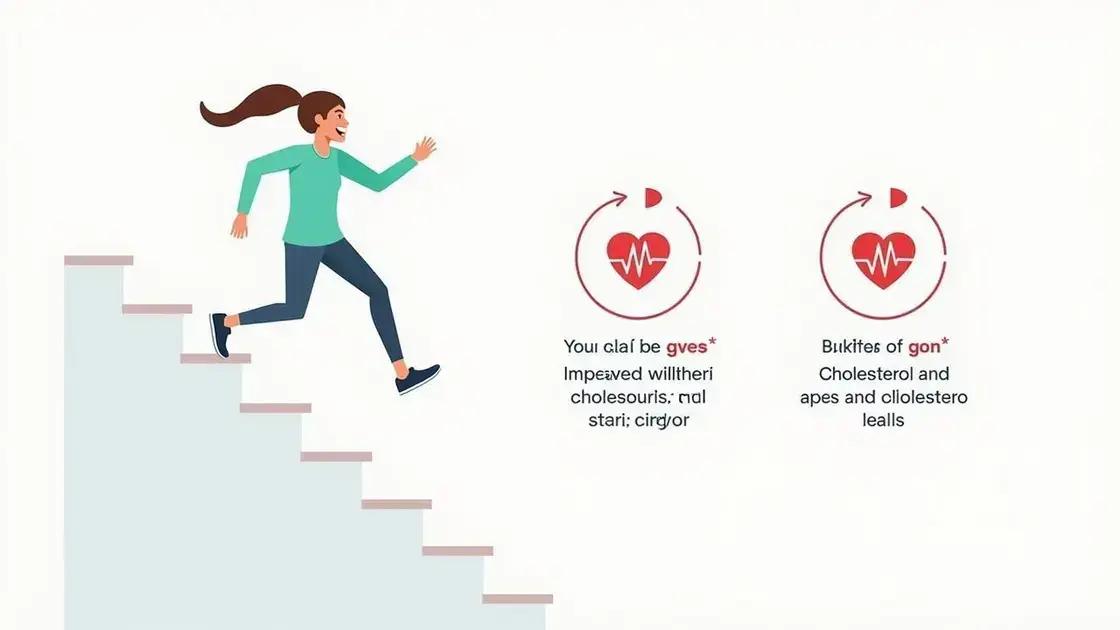Stair climbing is a highly effective exercise for enhancing cardiovascular fitness, strengthening heart health, and improving endurance. Regular stair climbing helps lower blood pressure and cholesterol levels, making it an excellent choice for maintaining overall cardiovascular health. Beginners can easily start this activity, while incorporating proper form, hydration, and varied intensity can further enhance workout effectiveness.
Stair climbing is an effective exercise that significantly contributes to cardiovascular fitness. It engages multiple muscle groups while boosting your heart rate, promoting better circulation and overall heart health. In this article, we’ll delve into how stair climbing works, its numerous benefits for cardiovascular fitness, and tips to enhance your workout.
Understanding Cardiovascular Fitness

Cardiovascular fitness refers to the ability of the heart, lungs, and blood vessels to supply oxygen to your body during sustained physical activity. When you have good cardiovascular fitness, your heart pumps blood efficiently, delivering oxygen to your muscles and organs. This is critical for overall health and longevity.
Understanding cardiovascular fitness involves knowing how it is measured. One common method is through VO2 max, which indicates how much oxygen your body can use during intense activity. The higher your VO2 max, the more efficient your body is at using oxygen, which directly influences your stamina and endurance.
Regular physical activity improves cardiovascular fitness, making your heart stronger and more efficient. Exercises that increase your heart rate and keep it elevated—like stair climbing—are particularly effective. These activities not only enhance your cardiovascular system but also increase your metabolism and improve your overall energy levels.
Why is cardiovascular fitness important? It contributes to better health by reducing the risk of heart disease, high blood pressure, diabetes, and other chronic conditions. Improved cardiovascular fitness also enhances your body’s ability to handle stress and fatigue, allowing for a better quality of life.
Incorporating activities like stair climbing into your routine can be an enjoyable and accessible way to boost your cardiovascular fitness. This not only helps you feel better physically but also benefits your mental health by reducing anxiety and improving mood.
How Stair Climbing Works

Stair climbing is a dynamic exercise that primarily targets your lower body while engaging your core and cardiovascular system. When you ascend stairs, your legs have to work harder against gravity, which increases your heart rate and challenges your muscles.
As you climb, your heart pumps more blood to supply the needed oxygen to your muscles. This process is what makes stair climbing an effective workout for cardiovascular fitness. Your body goes through several stages during this activity:
- Elevation: Each step upward requires powerful muscle contractions, particularly in your quadriceps, hamstrings, and calves. The more steps you climb, the more muscle fibers are engaged.
- Heart Rate Increase: The intensity of stair climbing elevates your heart rate quickly. This cardiovascular response helps strengthen the heart muscle over time, improving its efficiency.
- Energy Consumption: As you climb stairs, your body uses stored carbohydrates and fats for energy. This improves your metabolism, which is beneficial for weight management.
- Breathing Rate: Your breathing rate increases to bring in more oxygen. This promotes lung capacity and overall respiratory health.
Additionally, the rhythmic nature of stair climbing can boost your endurance. It is a weight-bearing exercise, helping to strengthen bones and maintain bone density. Over time, this can reduce the risk of osteoporosis.
Incorporating stair climbing into your fitness routine is simple. You can use actual stairs found in buildings, parks, or even home staircases. The accessibility of this exercise makes it suitable for many people, regardless of fitness level.
Benefits of Stair Climbing for Heart Health

Stair climbing offers numerous benefits for your heart health, making it an effective and accessible exercise for improving cardiovascular fitness. Regularly engaging in this activity can significantly reduce the risk of heart disease and related conditions.
One of the primary benefits is that stair climbing strengthens your heart muscle. As you climb, your heart works harder to supply oxygen to the muscles. Over time, this increased workload enhances the heart’s efficiency, allowing it to pump blood more effectively.
Another important benefit is the reduction of blood pressure. Consistent stair climbing can help decrease both systolic and diastolic blood pressure, making it an excellent exercise for those at risk of hypertension. Maintaining healthy blood pressure levels is crucial for reducing the risk of heart attack and stroke.
Additionally, stair climbing can improve your cholesterol levels. It aids in raising high-density lipoprotein (HDL) cholesterol, often referred to as “good” cholesterol. This helps to clear the arteries, lowering the likelihood of plaque buildup and arterial blockages.
Engaging in stair climbing also enhances your endurance, allowing the heart to pump blood more efficiently during daily activities. This improvement in endurance means that activities like walking, jogging, or even climbing stairs become easier over time.
Furthermore, stair climbing is a fantastic way to burn calories, which can help with weight management. Maintaining a healthy weight reduces strain on the heart and lowers the risk of cardiovascular diseases.
Incorporating stair climbing into your regular exercise routine can be an enjoyable and effective approach to boosting your heart health. Whether done in a gym or using nearby stairs, this simple activity offers significant benefits for anyone looking to enhance their cardiovascular fitness.
Tips for Effective Stair Climbing Workouts

To get the most out of your stair climbing workouts, following some effective tips can help enhance your performance and results. Here are some helpful guidelines:
Start Slow
If you’re new to stair climbing, start with a few minutes each day. Gradually increase the duration as your body adjusts. Listening to your body helps prevent injury.
Maintain Proper Form
Good form is crucial. Keep your back straight and your head up. Make sure to place your foot fully on each step, using your entire foot, to maintain balance and reduce strain.
Mix It Up
To keep your workouts interesting and challenging, vary your routine. Try alternating between fast-paced climbing and slower, controlled movement. You can also add lunges or side steps for variety.
Use Arm Movement
Incorporate your arms by pumping them as you climb. This helps enhance your cardiovascular workout and makes the movement feel more fluid and natural.
Stay Hydrated
Drink water before, during, and after your workout. Staying hydrated helps maintain your energy levels and improves performance while climbing stairs.
Set Goals
Setting achievable goals can keep you motivated. Whether it’s climbing a certain number of flights or timing your workouts, tracking your progress encourages consistency.
Track Your Heart Rate
Using a heart rate monitor can help you stay within your target heart rate zone. This is essential for maximizing the cardiovascular benefits of stair climbing.
By incorporating these tips into your routine, you can ensure that your stair climbing workouts are effective, safe, and enjoyable.
In summary, stair climbing is a powerful tool for enhancing cardiovascular fitness
Not only does it strengthen the heart and improve overall endurance, but it also offers significant benefits for heart health by reducing blood pressure and improving cholesterol levels.
Incorporating stair climbing into your routine can be easy and enjoyable. By following effective tips, such as maintaining proper form, varying your workouts, and setting achievable goals, you can maximize your results.
With consistency and dedication, stair climbing can become a vital part of your fitness journey, leading you toward a healthier and more active lifestyle.
FAQ – Frequently Asked Questions about Stair Climbing and Cardiovascular Fitness
What are the main benefits of stair climbing for cardiovascular fitness?
Stair climbing helps strengthen the heart, improve endurance, lower blood pressure, and enhance overall cardiovascular health.
How often should I incorporate stair climbing into my workout routine?
Aim for at least 2-3 times a week to see significant improvements in your cardiovascular fitness and heart health.
Is stair climbing suitable for beginners?
Yes, beginners can start slowly with short sessions and gradually increase intensity and duration as their fitness improves.
What is the proper form for stair climbing?
Maintain a straight back, keep your head up, and ensure that your entire foot lands on each step for balance and support.
Can stair climbing help with weight management?
Absolutely! Stair climbing is a great way to burn calories, which can aid in weight management when combined with a balanced diet.
How can I make my stair climbing workouts more effective?
Mix up your routine, include arm movements, and set achievable goals to enhance the effectiveness of your stair climbing workouts.












